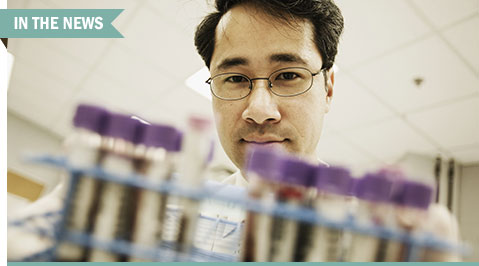 Image credit: Tim Pannell/Fuse/Thinkstock
Image credit: Tim Pannell/Fuse/Thinkstock
Want to reduce errors and turnaround time of test results and improve quality in your laboratory? Through various case studies and scenarios, an afternoon short course on July 26 at AACC's Annual Meeting & Clinical Lab Expo, “Laboratory Management Overview: ISO, TQM and Lean-Six Sigma Strategies” (192012), offers useful tips for laboratory management.
“The session will enable participants to consider a variety of quality management approaches that may be applied in their own institutions,” one of the session’s presenters, Anthony A. Killeen, MD, PhD, told CLN Stat. Those approaches include: ISO 15189, Total Quality Management (TQM), and Lean–Six Sigma.
Joining him as co-presenters will be Barnali Das, MD, DNB, PGDM, a consultant with the biochemistry and immunology division of Kokilaben Dhirubhai Ambani Hospital & Medical Research Institute, India, and Howard Morris, PhD, FAACB, ARCPA, a professor with the Hanson Institute’s Endocrine Bone Research Laboratory, South Australia.
Killeen, a professor and vice chair for clinical affairs at the University of Minnesota’s Department of Laboratory Medicine and Pathology, will discuss 2012 guidelines of ISO 15189 from the perspective of the College of American Pathologists (CAP).
“ISO 15189 is an international standard based on ISO/IEC 17025 and ISO 9001 that specifies requirements for competency and quality that are particular to medical labs. It focuses on the continuum of care connected with patient safety, risk mitigation, and operational efficiency,” he explained.
CAP’s ISO 15189 is available to CAP-accredited U.S. labs that already exceed federal standards in the Clinical Laboratory Improvement Amendments (CLIA) program, Killeen said.
“The differences between the Laboratory Accreditation Program and ISO 15189 relate to the emphasis on the laboratory's technical performance of testing in the former and the emphasis on the quality management system in the latter. These two programs are complementary,” according to Killeen.
Das, the session’s moderator, will inform attendees on how they can “cut the extra flab” from their lab platter by adopting Lean-Six Sigma.
This system can help labs achieve a number of objectives: reduce time traps; eliminate non-value-added steps; focus on the value-added steps, and reduce complexity in the work flow process, Das told CLN Stat.
“Sigma metrics help us to use the current state value stream maps, in order to identify opportunities for using Lean–Six Sigma strategies in the laboratory process flow. To this end, the laboratory process flow has to be designed according to the DMAIC flow, i.e., Define, Measure, Analyze, Improve and Control,” Das explained.
Morris plans to discuss TQM from the perspective of the International Federation of Clinical Chemistry and Laboratory Medicine (IFCC). This perspective “is dependent on the responsibilities for a federation of 89 national societies and 47 corporate members as the leading international professional organization in laboratory medicine,” Morris told CLN Stat.
IFCC places an emphasis on quality analytical performance as the foundation for all clinical laboratories and processes, including the implementation of internal quality control and external quality assurance, Morris said.
“Further development of clinical laboratory quality requires clinical laboratory specialists to look outside the laboratory to improve pre- and post-analytical processes. This is the area where most errors currently occur, with less than 10% of errors occurring within the analytical phase of the clinical laboratory process,” he said.
He added that labs should take responsibility for the training and education of these procedures, which are often conducted by non-lab personnel.
The ISO 15189 2012 guidelines, TQM, and Lean-Six Sigma collectively promote an environment that emphasizes patient safety and quality patient care. Following this session, Das said she expects that participants will be able to:
- Implement TQM components as quality laboratory processes, quality control, quality assessment, quality planning, and quality goals;
- Identify ‘critical to quality’ components based on the value stream map of the laboratory;
- Design laboratory process flow, following ‘Define, Measure, Analyze, Improve and Control’ principles;
- Calculate defect per million opportunities to forecast effectiveness of Lean-Six Sigma; and
- Prepare for inspection readiness as per ISO 15189: 2012 guidelines